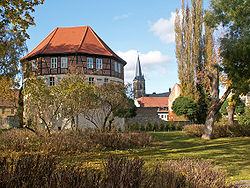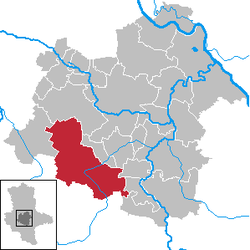Aschersleben
Aschersleben | |
|---|---|
 View from Rondell to St.Stephan Church | |
 Coat of arms | |
show Location of Aschersleben within Salzlandkreis district | |
 Aschersleben | |
| Coordinates: 51°45′N 11°28′E / 51.750°N 11.467°ECoordinates: 51°45′N 11°28′E / 51.750°N 11.467°E | |
| Country | Germany |
| State | Saxony-Anhalt |
| District | Salzlandkreis |
| Subdivisions | 6 |
| Government | |
| • Mayor (2015–22) | Andreas Michelmann[1] |
| Area | |
| • Total | 156.31 km2 (60.35 sq mi) |
| Elevation | 114 m (374 ft) |
| Population (2020-12-31)[2] | |
| • Total | 26,737 |
| • Density | 170/km2 (440/sq mi) |
| Time zone | UTC+01:00 (CET) |
| • Summer (DST) | UTC+02:00 (CEST) |
| Postal codes | 06449 |
| Dialling codes | 03473 |
| Vehicle registration | SLK, ASL |
| Website | www |
Aschersleben (German pronunciation: [ˈaʃɐsleːbən] (![]() listen)) is a town in the Salzlandkreis district, in Saxony-Anhalt, Germany. It is situated approximately 22 km east of Quedlinburg, and 45 km northwest of Halle (Saale).
listen)) is a town in the Salzlandkreis district, in Saxony-Anhalt, Germany. It is situated approximately 22 km east of Quedlinburg, and 45 km northwest of Halle (Saale).
History[]
Pre-20th century[]
Aschersleben was first mentioned in 753, making it the oldest town of Saxony-Anhalt. The Latin name of the town's castle, Ascharia, provided the name of the House of Ascania. From 1252–1315 Aschersleben was the capital of Anhalt-Aschersleben, after which it passed to the Bishopric of Halberstadt. After the 1648 Peace of Westphalia, it became part of the Principality of Halberstadt. Aschersleben became part of the Prussian Province of Saxony in 1815.
Nazi Germany[]
A Junkers serial fuselage production facility was located in Aschersleben during the time of Nazi Germany. In April 1935 tools were transferred to Aschersleben, and by May 1935 the first fuselages were built there. The facility was located in the Wilslebener Strasse 9 near the so-called Seewiesen, where an airfield was erected as well. The Aschersleben shop area reached 564,000 square metres and about 6,000 people were employed at it.
During World War II, a subcamp of the Buchenwald concentration camp was located in the town. It was established to provide slave labour for Junkers (aircraft) and Motorenwerk (automotive).[3]
Since July 1944 about 950 KZ prisoners were forced to work at the Junkers Flugzeugwerke in Aschersleben. In April 1945 the production was ceased. On 17 April U.S. forces occupied Aschersleben, but on 23 May the town was handed over to the British forces and later on 1 July it was finally handed over to the Soviets.
Aschersleben was bombed on the following dates during the war:
- 1 April 1942 first British bomb attack
- 20 February 1944 U.S. day attack, failed target due to cloudy weather
- 31 March 1945
- 14 April 1945
At the end of World War II Junkers-Aschersleben was mostly intact and the production was just changing for the production of the jet fighter Heinkel He 162. Most installations were dismantled and transferred to Kiev in the Soviet Union by the Soviets in 1946. The remaining facility buildings at Aschersleben were later used by VEB Kombinat Fritz Heckert. Today the area is used by Schiess AG.
Post-1945[]
Aschersleben was part of East Germany until 1990, when it became part of Saxony-Anhalt during German reunification. On 1 January 2008, the municipalities of Drohndorf, Freckleben and Mehringen were incorporated into Aschersleben.
Architecture[]


Several architectural styles are represented in Aschersleben. The historic centre is dominated by romanesque (Grauer Hof), gothic (St. Stephani Church), renaissance (Town hall, Krukmannsches Haus) and baroque architecture.
There is a ring of buildings in neoclassical and Jugendstil styles around the historic Old Town. This, in turn, is surrounded and interspersed with buildings of early modernism like the Heckner-Bauten and buildings from the GDR era. Large new areas are mainly in the north and south-east of the town.
Aschersleben is one of few German towns showing large segments of the medieval city wall preserved through the centuries, although often integrated into later residential buildings. The city wall defines a promenade ring around the historic Old Town. In the 19th century, several city gates and towers had been demolished, but out of 51 towers and bastions there are still 15 existing.
There are few half-timbered buildings in the old town of Aschersleben. The reasons for this is the availability of good stone material and the absence of large forests in the vicinity, as well as numerous fires before the 16th century. Nevertheless, there are numerous buildings, which are partly half-timbered, usually the upper floors.
Twin towns – sister cities[]
Aschersleben is twinned with:[4]
 Kerava, Finland
Kerava, Finland Peine, Germany
Peine, Germany Trenčianske Teplice, Slovakia
Trenčianske Teplice, Slovakia
Notable people[]

- Adam Olearius (1603–1671), writer and diplomat
- Johann Esaias Silberschlag (1721–1791), theologian and scientist
- Johann August Ephraim Goeze (1731–1793), zoologist
- Franz Körte (1782-1845), natural and agricultural scientist
- Wilhelm Friedrich Wieprecht (1802–1872), composer
- Rudolf Christian Böttger (1806–1881), inorganic chemist
- Martin Schmidt (1863-1947), geologist and paleontologist
- Robert Leffler (1866-1940), actor and singer
- Gerd von Rundstedt (1875–1953), World War II general, field marshal
- Richard Schoenfeld (1884-1956), sculptor and painter
- Theodor Osterkamp (1892-1975), Navy pilot in World War I, Luftwaffe Commodore in World War II
- Walter Andreas Schwarz (1913–1992), singer, writer, comedian, radio playwright and translator
- Lilo Ramdohr (1913-2013), member of the anti-fascist group White Rose.
- Ernst Klodwig (1903–1973), Formula 1 driver
- Helmut Stein (born 1942), footballer
Wendell Lewis Willkie (1892–1944) was the Republican Party (GOP) nominee for the 1940 presidential election. Born Lewis Wendell Willkie in Elwood, Indiana, he was the son of Herman Willkie, a German immigrant from Aschersleben.
Gallery[]
Scharren arcades

Town hall
Marsfeld watchtower
Johannisturm
Krukmannsches Haus, Wallensteins quarters

Vorderbriete
References[]
- ^ Bürgermeisterwahlen in den Gemeinden, Endgültige Ergebnisse, Statistisches Landesamt Sachsen-Anhalt, accessed 8 July 2021.
- ^ "Bevölkerung der Gemeinden – Stand: 31. Dezember 2020" (PDF). Statistisches Landesamt Sachsen-Anhalt (in German). June 2021.
- ^ Edward Victor. Alphabetical List of Camps, Subcamps and Other Camps. "Archived copy". Archived from the original on 2010-12-16. Retrieved 2008-07-25.CS1 maint: archived copy as title (link)
- ^ "Partnerstädte von Aschersleben". aschersleben.de (in German). Aschersleben. Retrieved 2021-02-28.
External links[]
| Wikimedia Commons has media related to Aschersleben. |
- Official website (in German)
- Private photo website (in German)
- Towns in Saxony-Anhalt
- Salzlandkreis
- Province of Saxony
- Bezirk Halle
- Members of the Hanseatic League








